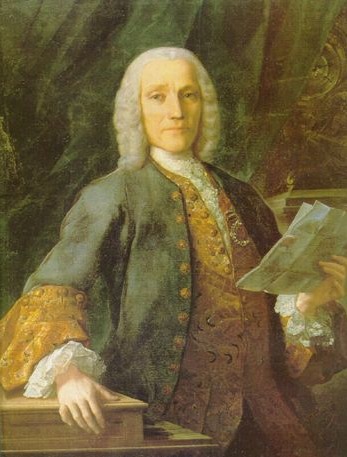
Domenico Scarlatti by Domingo Antonio Velasco 1738
Domenico Scarlatti was an Italian composer who spent much of his life in Spain and Portugal. He was extremely influential in the development of the Classical period in music through his individual style, though he lived mostly during the Baroque era.

Scarlatti
Scarlatti was born in Naples, Italy, in 1685, the same year as two other baroque masters, Johann Sebastian Bach and George Frederic Handel. He was the sixth of ten children and a younger brother to Pietro Filippo Scarlatti, also a musician. Most probably he first studied under his father, the composer and teacher Alessandro Scarlatti; other composers who may have been his early teachers include Gaetano Greco, Francesco Gasparini, and Bernardo Pasquini, all of whom seem to have influenced his musical style.
He became a composer and organist at the royal chapel in Naples in 1701. In 1704, he revised Carlo Francesco Pollarolo's opera Irene for performance at Naples. Soon after this his father sent him to Venice; no record exists of his next four years. In 1709 he went to Rome in the service of the exiled Polish queen Marie Casimire, where he met Thomas Roseingrave who would later lead the enthusiastic reception of the composer's sonatas in London. Already an eminent harpsichordist, there is a story that in a trial of skill with George Frideric Handel at the palace of Cardinal Ottoboni in Rome he was judged perhaps superior to Handel on that instrument, although inferior on the organ. Later in life, he was known to cross himself in veneration when speaking of Handel's skill.

Scarlatti
Also while in Rome, Scarlatti composed several operas for Queen Casimira's private theatre. He was maestro di cappella at St Peter's from 1715 to 1719, and in the latter year came to London to direct his opera Narciso at the King's Theatre.
In 1720 or 1721 he went to Lisbon, where he taught music to the Portuguese princess Maria Magdalena Barbara. He was at Naples again in 1725. During a visit to Rome in 1728 he married Maria Caterina Gentili. In 1729 he moved to Sevilla where he stayed for four years. There he got to know the Flamenco. In 1733 he went to Madrid as music master to the princess, who had married into the Spanish royal house. Maria Barbara became Queen of Spain, and he remained in Spain for some twenty-five years and had five children there. After the death of his wife in 1742 he married a Spaniard, Anastasia Maxarti Ximenes. During his time in Madrid, Scarlatti composed over five hundred keyboard sonatas. It is for these works that he is best remembered today.
Scarlatti befriended the castrato singer Farinelli, a fellow Neapolitan enjoying royal patronage in Madrid. The musicologist Ralph Kirkpatrick acknowledges Farinelli's correspondence as providing "most of the direct information about Scarlatti that has transmitted itself to our day."
Domenico Scarlatti died in Madrid, aged 71. His residence on Calle Leganitos is designated with a historical plaque, and his descendants still live in Madrid. Today, a number of his portraits still survive, though it is quite possible that there are still some in unknown locations. Still wondering about an 18th century portrait in your family collection? Contact us... it could be of Domenico Scarlatti.
